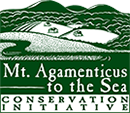Seacoast Online | May 17, 2016 | By Deborah McDermott |
YORK, Maine — A transformation is taking place these days in the heart of York Village, as a consortium of town workers, York Public Library trustees, school children, garden club members and York Land Trust employees band together to create a healthy ecosystem and to beautify the area around the library pond.

Dylan Munn and Mary Kocev take a minute from their work planting violas to talk about why they volunteered Saturday on the library pond project. The two were among almost a dozen York Middle and High School students who gave up their time to help plant. Photo by Deborah McDermott/Seacoastonline
Volunteers were out in force at the pond last Saturday, planting hardy native species that will help filter pollutants from getting into the pond and include flowering perennials for native pollinators like bees. Funding for the material came from a $15,000 Wheeler Trust grant.
The work caps a several-year effort started by Joe Anderson, York Land Trust stewardship director. The pond, located in the front of the library, is under a land trust conservation easement. It is actually a retention pond for the library property and for the area across Long Sands Road.
“It has quite a large watershed,” said Anderson. “That pond accepts a lot of runoff that includes dog poop, fertilizer, pesticides. It’s a natural area but it’s also a stormwater utility. It takes a beating, so you have to put a lot into it to make it into an inviting place.”
When Anderson first began a management plan for the pond, it was clogged with phragmites, a wetland species of common reed that is incredibly invasive, he said. “It comes in on fill and it and it grows quickly and monopolizes the whole area. You couldn’t even see the pond from some angles back then.”
Methodically he has worked to rid the pond of phragmites, sometimes individually pulling them up – and the work’s still not done, although now “there are just a handful of plants. A little bit more work and it will be under control.”
In addition to the stormwater runoff into the pond, the area by the library entrance is used as a snow pile by the town public works department. That snow, when melted, adds salt to the mix, as well.
In addition, plants and shrubs bordering Long Sands Road were being choked by bittersweet, another invasive species. Public works employees have cleaned the entire area out, to make way for the plants and shrubs.
Fortunately, said landscaper Stacey Scontras, as the idea for beautifying the pond area came to fruition, she was able to refer to the library master plan created in 1998. “Initially it was created as a woodland garden, and so we’re using a lot of the same plant material,” she said.
The plan calls for using the shrub clethra, as well as iris, ferns, lobelia, marsh marigolds and violas. The idea, said Anderson, “is to make it a natural system as much as possible. The native species filter pollutants from the snow dump. The flowering plants will attract native pollinators, too.”
York Middle School life science teacher Margot Simonds convinced a group of seventh- and eighth-graders to give up a Saturday morning to plant alongside Piscataqua Garden Club members. Simonds said she likes to encourage students to work on environmental projects that benefit their community. “It’s important that what we do in the school connects with their world,” she said, “because they’re the future.”
Seventh-grader Mary Kocev, already a member of the school’s environmental team, said as she planted violas, “this is a good project. This will really help the entire community.”
“I feel like people will come here more from now on,” said York High School student Dylan Munn. “And maybe the animals will come back, like ducks and turtles.”
Bernadine Speers, chair of the library board of trustees, said the board is gratified that so many groups came together to work on the project.
“It is an educational experience as well as a model for how well different parts of the community can work together,” she said. “The library is very grateful to everyone who has participated in this endeavor.”

